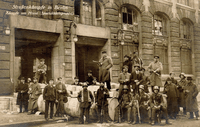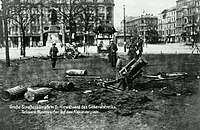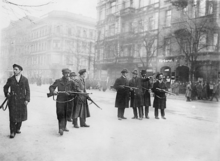Spartacist uprising
The Spartacist uprising (German: Spartakusaufstand), also known as the January uprising (Januaraufstand), was a general strike (and the armed battles accompanying it) in Berlin from 5 to 12 January 1919. Germany was in the middle of a post-war revolution, and two of the perceived paths forward were social democracy and a council republic similar to the one which had been established by the Bolsheviks in Russia. The uprising was primarily a power struggle between the moderate Social Democratic Party of Germany (SPD) led by Friedrich Ebert and the radical communists of the Communist Party of Germany (KPD), led by Karl Liebknecht and Rosa Luxemburg, who had previously founded and led the Spartacist League (Spartakusbund).
| Spartacist Uprising | |||||||
|---|---|---|---|---|---|---|---|
| Part of German Revolution of 1918–1919 | |||||||
 Soldiers on the Brandenburger Tor during the Spartacist uprising | |||||||
| |||||||
| Belligerents | |||||||
|
| |||||||
| Commanders and leaders | |||||||
|
|
| ||||||
| Strength | |||||||
| 3,000 Freikorps | |||||||
| Casualties and losses | |||||||
|
17 killed 20 wounded | 156–196 insurgents and civilians killed | ||||||
The revolt was improvised and small-scale and was quickly crushed by the superior firepower of government troops.[1] Berlin was largely undisturbed.[1] Long-distance trains continued to run on time and newspapers remained on sale, as the rebels passively confined themselves to only a few select locations.[1] Similar uprisings occurred and were suppressed in Bremen, the Ruhr, Rhineland, Saxony, Hamburg, Thuringia and Bavaria, and a round of bloodier street battles occurred in Berlin in March.
Background
After their experiences with the SPD and the Independent Social Democratic Party of Germany (USPD), the Spartacists concluded that their goals could be met only in a party of their own, and they founded the Communist Party of Germany (KPD) at the end of 1918. Because of the unhappiness of many workers with the course of the revolution, they were joined by other left-socialist groups. After deliberations with the Spartacists, the Revolutionary Stewards decided to remain in the USPD.
Rosa Luxemburg drew up her founding programme and presented it on 31 December 1918. In this programme, she pointed out that the communists could never take power without the clear support of the majority of the people. On 1 January she again demanded that the KPD participate in the planned elections, but she was outvoted. The majority hoped to gain power by continued agitation in the factories and by "pressure from the streets".
Strikes and uprising
As in November 1918, a second revolutionary wave developed on 4 January 1919 when the government replaced the Police Chief of Berlin, Emil Eichhorn, who was a member of the USPD and who had refused to act against the demonstrating workers during the Christmas Crisis, by Eugen Ernst. The USPD, the Revolutionary Stewards and KPD took up Eichhorn's call for a demonstration to take place on the following day.[2] To the surprise of the organizers, the demonstration turned into a huge, mass demonstration which also attracted the support of many Socialist Party members. On Sunday 5 January, as on 9 November 1918, hundreds of thousands of people poured into the centre of Berlin, many of them armed. In the afternoon the train stations and the newspaper district with the offices of the middle-class press and the SPD's "Vorwärts", which had been printing articles hostile to the Spartacists since the beginning of September, were occupied. Some of the middle-class papers in the previous days had called not only for the raising of more Freikorps but also for the murder of the Spartacists.
The leaders of the movement assembled at Police Headquarters and elected a 53-member "Interim Revolutionary Committee" (Provisorischer Revolutionsausschuss), which failed to make use of its power and was unable to agree on any clear direction. Liebknecht demanded the overthrow of the government. Rosa Luxemburg, as well as the majority of KPD leaders, considered a revolt at this moment to be a catastrophe and explicitly spoke out against it.
The leaders of the USPD and KPD called for a general strike in Berlin on 7 January, and the subsequent strike attracted about 500,000 participants who surged into downtown Berlin. Within the strike, some of the participants organized a plan to oust the more moderate social democrat government and launch a communist revolution. Insurgents seized key buildings, which led to a standoff with the government. During the following two days, however, the strike leadership (known as the ad-hoc "Revolution Committee") failed to resolve the classic dichotomy between militarized revolutionaries committed to a genuinely new society and reformists advocating deliberations with the government. Meanwhile, the strikers in the occupied quarter obtained weapons.
At the same time, some KPD leaders tried to persuade military regiments in Berlin, especially the People's Navy Division, the Volksmarinedivision, to join their side, however they mostly failed in this endeavour. The navy unit was not willing to support the armed revolt and declared themselves neutral, and the other regiments stationed in Berlin mostly remained loyal to the government.
On 8 January, the KPD resigned from the Revolutionary Committee after USPD representatives invited Ebert for talks. While these talks were taking place, the workers discovered a flyer published by Vorwärts entitled "Die Stunde der Abrechnung naht!" (The hour of reckoning is coming soon!) and about the Freikorps (anti-Communist paramilitary organizations) being hired to suppress the workers. Ebert had ordered his defense minister, Gustav Noske, to do so on 6 January. When the talks broke off, the Spartacist League then called on its members to engage in armed combat.
 Group photograph of Spartacist militia during the fighting in Berlin in January 1919
Group photograph of Spartacist militia during the fighting in Berlin in January 1919 German troops with a heavy mortar during the January uprising.
German troops with a heavy mortar during the January uprising. Spartacist irregulars holding a street in Berlin
Spartacist irregulars holding a street in Berlin
Attack by the Freikorps
On the same day, Ebert ordered 3,000 Freikorps soldiers to attack the Spartacists. These former soldiers still had weapons and military equipment from World War I, which gave them a formidable advantage. They quickly re-conquered the blocked streets and buildings and many of the insurgents surrendered. Between 156 and 196 insurgents[3] and 17 Freikorps soldiers died during the fighting.
Execution of Luxemburg and Liebknecht
At 21:00 on 15 January, Luxemburg and Liebknecht were discovered in a Berlin-Wilmersdorf apartment by a citizen militia, arrested and brought over by car to the headquarters of the largest Freikorps unit, the heavily armed Garde-Kavallerie-Schützen-Division, at the Eden-Hotel.[4] The division's first staff officer, Major Waldemar Pabst, had them questioned.[5] He then called over the Marine-Squadron-Pflugk of torpedo boat captain Horst von Pflugk-Harttung, whom he ordered to transfer Liebknecht from the hotel to Moabit prison.[6] Liebknecht was beaten up, driven to Tiergarten Park and executed at close range with three shots.[7] The body was delivered as an unidentified man to a morgue.[7]
Thirty minutes later, Luxemburg was brought through the hotel lobby, where a guard hit her twice in the head with his rifle butt.[7] More soldiers and officers joined in beating her up.[7] Luxemburg may already have been dead at this point.[7] She was moved to a truck and shot once in the back of the head.[7] Her body was thrown into the Landwehr Canal, where, despite searches by fire-brigade divers, it was not found till months later on 1 June.[8]
See also
Citations
- Jones 2016, p. 183.
- "1919: The Spartacist Uprising". Weimar and Nazi Germany. September 29, 2013.
- Jones 2016, p. 197.
- Jones 2016, p. 234.
- Jones 2016, pp. 234–235.
- Jones 2016, p. 235.
- Jones 2016, p. 236.
- Jones 2016, pp. 236–237.
Bibliography
- Jones, Mark (2016). Founding Weimar: Violence and the German Revolution of 1918–1919. Cambridge: Cambridge University Press. ISBN 978-1-107-11512-5.CS1 maint: ref=harv (link)
Further reading
- Bassler, Gerhard P. (1973). "The Communist Movement In The German Revolution, 1918–1919: A Problem Of Historical Typology?". Central European History. 6 (3): 233–277. doi:10.1017/s000893890001623x.CS1 maint: ref=harv (link)
- Haffner, Sebastian (1973) [1968]. Failure of a revolution: Germany, 1918–19. New York: Library Press. ISBN 9780912050232.
- Waldman, Eric (1958). The Spartacist Uprising of 1919 and the Crisis of the German Socialist Movement: A Study of the Relation of Political Theory and Party Practice. Milwaukee: Marquette University Press.
External links
